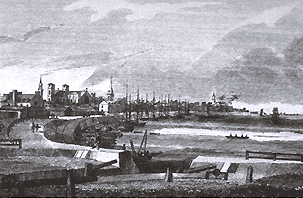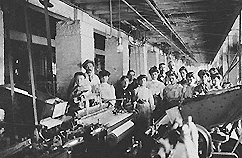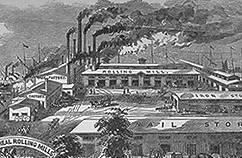The cradle of industrialization
Lachine Canal National Historic Site
A change of direction
In the first half of the 19th century, Canadian industry was embryonic. Until that time, Canada had supplied Great Britain with raw materials, which returned in the form of manufactured goods. Only a few activity sectors related to transportation and the transformation of raw materials were still somewhat dynamic: shipbuilding, blacksmithing and foundries, sawmills, elevators and flour mills, tanneries, distilleries and breweries.

Union (1840) and Confederation (1867) would help strengthen a domestic market large enough to enable the rise of manufacturing. The growth of shipping and the first railway boom would encourage the development of heavy industry and a multitude of businesses associated with the building of ships and railways. Around 1840, Montréal had several assets that would help it become an important industrial centre. Having one of the largest Canadian ports, this city was also the country's financial and commercial centre. The completion of the canal up to the Great Lakes and the development of the railway network would turn it into a transportation hub.
The beginning of industrialization
Montréal underwent its first industrial boom in 1848, when the Lachine Canal was first widened, making available a new power source. Wise investors jumped at the opportunity of setting up new businesses or increasing their establishments' level of production, as in the case of flour mills and foundries.
The exploitation of hydraulic power from Basin No. 2 and the Saint-Gabriel sector would stimulate substantial investments within a few years in about thirty businesses, several of which were completely new. In 1879, at the end of the first installation phase, the industry became an important component of Montréal's economic activity.
Rapid growth

From 1880 to 1896, industrial development continued and even speeded up in some areas. First grouped together around hydraulic sites, the industries gradually occupied all of the canal's banks to the east of the Côte-Saint-Paul Lock. This growth, which lasted until 1896, stemmed in large part from the "National Policy". This is when the large textile industry appeared.
Finally, from 1896 to 1939, development was characterized by an increase in large businesses. Industries began to progressively occupy the west sector of the canal in the cities of Saint-Pierre and LaSalle. These new businesses specialized in the chemical and petrochemical fields as well as in iron and steel production.
Years of fame and glory

Large businesses experienced their hour of glory on the canal's shores. From the beginning, the production of the three flour mills set up around Basin No. 2 totalled 65% of the production in Eastern Canada whereas that of the neighbouring nail factories represented over 80%. Augustin Cantin's shipyard in the Saint-Gabriel sector was by far the most important in Montréal. The Canada Sugar Company, the first Canadian sugar refinery founded by John Redpath in 1854, employed about one hundred workers who produced 300 barrels of sugar per month. The Frothingham & Workman business in Côte Saint-Paul ranked as one of the largest tool factories of the period.

Over the decades, impressive businesses in terms of their size, manpower and production scale sprung up as a result of incorporation or mergers with competitors. This is what happened to the Ogilvie Company, which eventually bought out all its competitors and became the most important milling operation in the British Empire and the largest private flour mill in the world. The Montreal Rolling Mills, established in 1868, gradually acquired all the nail factories and other companies specializing in iron and steel products. They finally merged with four other companies to form the Steel Co. of Canada in 1911, commonly known as Stelco.
Brand image: diversity and interdependence
More than 600 businesses have occupied the lands neighbouring the canal from its construction to the present day. Taken as a whole, they cover all the manufacturing production groups. New businesses continually replace the more outmoded and less efficient ones.
The interdependence between these businesses was another dominant feature of this corridor. The shipyards and rolling stock railway factories were the motors of development. Many businesses specialized in one of the phases of production (sawmills, cabinet making, painting or upholstery businesses, foundries, etc.) formed true industrial clusters.
Spin-offs into neighbouring areas
These few examples illustrate the importance of the Lachine Canal in the history of Montréal and of Canada. A cradle of Canadian industry, this corridor housed a few of the dominant companies in that era.
As well, the industrialization of the canal helped shape the city's social and urban profiles. It led to the rapid growth of the working class. Thousands of workers attracted by the new factories moved within the vicinity of their work, giving birth to the working-class neighbourhoods of South-West Montréal.
- Date modified :